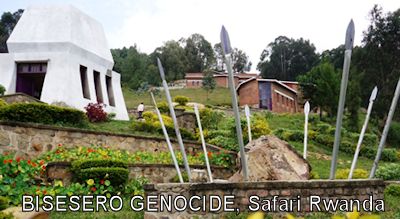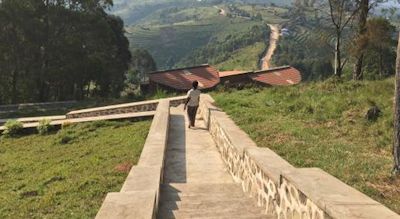Rwanda Safari
The Tales of Bisesero Genocide Resistance Memorial, Rwanda Cultural Safaris
 The Bisesero Resistance
The Bisesero Resistance
The Bisesero memorial site is a unique site that was constructed within the Bisesero area after it was swept by a wave of bitterness during the 1994 genocide. The Tutsi people in this region during the genocide came together to form resistance against the people who were trying to kill them. They retreated within the hills where this memorial is constructed and while there they would keep the enemy away by throwing sticks plus rocks at their attackers. This was actually the strongest resistance that the Tutsi held during that brutal time.this place can be visited during our Rwanda Cultural Safaris.
However this did not hold for long, the hutu attackers received more reinforcements who came with modern weapons. The Tutsi were overpowered with over 50% of them killed while the rest retreated further up the hills.
By the end of the month of the French Operation Turquoise came in and created a “safe zone” within the southwestern part of Rwanda. About 1500 of people who had sought refuge in the hills of Bisesero survived although more than 10,000 are believed not to have survived those brutal days.
The Bisesero Memorial Tourist Site
The biggest part of the genocide site comprised of a somewhat meandering path leading up the sharp hillside. This path symbolizes how the victims of the genocide ascended these hills as they fled the genocide brutality. This path goes through the 9 different tiny buildings which area arranged in groups of threes.
The path begins at the foot of the hill right at the memorial gate. After the gate you will find a symbolic sculpture that represents the 9 Kibuye sectors. It comprises of 9 spears arranged in a circular way pointing upwards – and these show the united resistance that was exhibited by the people in this region during the genocide.
The nine different memorial buildings house a number of displays that include piles of bones, skulls arranged in rows some of the weapons that were used by the attackers. A visit to this place will give you a proper insight of the brutality that happened within this area. There are also mass graves that where built in 2004.
Between 9th April and 30th June 1994, the Bisesero Region was a big target and suffered daily attacks in during the genocide. The attackers were armed with firearms, clubs, grenades spears and machetes plus a number of other weapons. Among the people who attacked included armed civilians, gendarmes, and policemen from Gisovu as well as Gishyita as well as the Interahamwe (a para-military group comprising mainly of the Hutu extremists).
The genocide and the desperation of the resistance that characterized the events which occurred in the hills of the Bisesero Area, appear to have had serious effects on its landscape. The change in its landscape was likely due to the attacks and the resistance, that included several people moving in the area, plus thousands of decomposing corpses exposed right on top. When you look at the history of this place, it’s no surprise that there were thousands of dead bodies littered.
Up to date the government of Rwanda has not been able to ascertain  the exact number of people who died within this region. However, it’s estimated that there are at least14, 000 people who died and many others whose whereabouts up to date remain unknown. Actually sad to say is that this region which covers about 35 square kilometers had a ratio of over 400 dead bodies per square kilometer. Moving on in the areas where the genocide resistance was strongest within the Bisesero region you will find that there were over 640 dead bodies per square kilometer.
the exact number of people who died within this region. However, it’s estimated that there are at least14, 000 people who died and many others whose whereabouts up to date remain unknown. Actually sad to say is that this region which covers about 35 square kilometers had a ratio of over 400 dead bodies per square kilometer. Moving on in the areas where the genocide resistance was strongest within the Bisesero region you will find that there were over 640 dead bodies per square kilometer.
When you look at the maps of this region, you will realize that it was separated into three different sections or features that include I, II, as well as III. Section I represents the areas where the genocide and the resistance activities were most and this section experienced so much change in its landscape
Section II represents the trails and roads which trace River Kirparo River together with its tributaries; the trails were commonly used during the genocide so they only became visible after that wave of bitterness.
Section III represents a section that remains as a memorial to all the victims of the genocide.
For more information about Rwanda cultural Safari, visit gorillasafarirwanda.com
